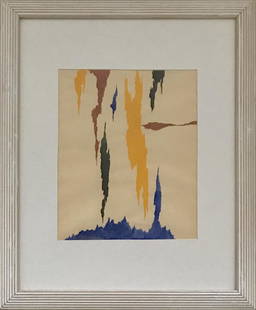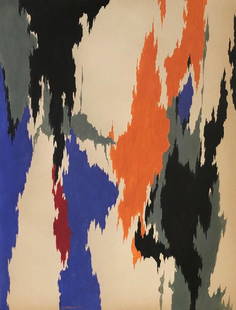
Standing male "malagan" figure - Papua New Guinea -
Similar Sale History
View More Items in Militaria & War MemorabiliaRelated Militaria & War Memorabilia

More Items in Militaria & War Memorabilia
View MoreRecommended Collectibles
View More






Item Details
Description
wood ("Alstonia scholaris"), shell inlay ("Turbo Phetolatus opercula"), lime, red ochre, black pigment, hairdo from short cut brush-like plantfibre tufts, which were pressed in blackish mass, thin vertical braces as characteristic accessory part: with bird head to the front and snake heads on both sides, the object in front of the body possibly a music instrument "katoviso" (bamboo flute), painted in traditional colours in white, red and black, painted "kapkap" on the breast, projection to anchor the figure in the ground, inscription at the same place: "VI 34436" and old label attached: "Neu Mecklenburg Slg. Heinrich", fragmentary, various missing parts, restored in various places, cracks, abrasion of paint, hair missing in parts;
the term "malagan" refers collectively to a complex series of ceremonies and the visual art forms associated with them. There are three basic types of "malagan" carvings: horizontal friezes, individual figures carved in the round and upright columns that depict figures on top of each other. Throughout life, individuals seek to acquire rights to specific "malagan" images and the rituals associated with them. Men, in particular, compete to obtain rights to the greatest number of "malagan", possession of which confers status and prestige.
The most numerous and impressive "malagan" carvings are commissioned for display during the final memorial ceremony commemorating the deceased. The aim of this ceremony is to "finish the dead". This is done by remembering him with all his achievements for one last time - and then forgetting him. This approach requires that all of the deceased's legal and personal matters be settled, that his land and other rights be transmitted, and that his positions in clan and community be taken over by successors. On a more esoteric note, it includes the recapturing of his life force, the energy of which is thought to reside in the "malagan" objects during the festival, and to be dispersed and activated among the participants at the end of the ceremony.
After extensive preparation the final memorial ceremonies take place several years after the death.The feast includes the construction of a "malagan" house for the presentation of the art objects, the appearance of masked dancers at dawn, the presentation of larger quantities of shell money, the feasting on large amounts of taro, pork and bananas and the slaughtering of a vast number of pigs that are presented in front of the "malagan"house while respected elders offer speeches and preside over the ritual exchange that closes the ceremony. Male dancers wearing "tatanua" masks and feather decorations, and women's dance groups carrying either leaves or dance wands in their hands, will appear, supported by songs and/or the beating of small drums made of bamboo. Afterwards, the "malagan" carvings, having served their purpose, are destroyed, allowed to rot, or sold to outsiders.
The present "malagan" figure was collected in-situ within the framework of the German Navy expedition of 1907-1909 by the Berlin anthropologists Edgar Walden and came through him into the possession of the Ethnological Museum in Berlin in 1910. In 1939, the piece was exchanged in spectacular fashion by the museum with the dealer Arthur Speyer II. Speyer received, in exchange for a ?sun-malagan? acquired from the Linden-Museum in Stuttgart, objects with a value 7,000 Reichsmarks. Unfortunately the objects were never listed. It is possible though, by checking the collection catalogue, to reconstruct which objects are no longer present thus indicating which objects were exchanged. On this list there is a "malagan" under the inventory number "VI 34436 (see M. Schindlbeck, page 264).
Through the activities of his father, Arthur Max Heinrich Speyer II (1894-1958) came into contact with all kinds of ethnographic objects. As a young man, he specialized in equipping company exhibitions and made films of ethnographic objects. In addition, he acquired an extensive private collection, with objects from North American Indians, pre-Columbian, Cameroon, and especially from Papua New Guinea all of which were kept in the living quarters of the family. Special pieces were apparently kept in a "dark room" that were only shown to selected guests. It is particularly noteworthy that neither Arthur Speyer II, nor his father ever collected objects in-situ. By contrast, Arthur Speyer took advantage of the situation and began to trade items with museums like his father. Other sources for his collection were colonial officers and administrators of the former German colonies, old aristocratic estates and castle collections.
During the Second World War the Speyer collection was miraculously largely spared from bombs and looting: "The house was occupied by Siberian troops. As the soldiers forcibly opened the basement, they found Sepik skulls that lay on a table. Deeply alarmed, the soldiers fled and the objects were spared.? It speaks a great deal for the Speyer collection that the Ethnological Museum of Berlin offered to evacuate the collection. After Speyers? death, some of the objects were returned to German museums. However, at the instigation of Ted J. Brasser (he had formerly worked at the Leiden Ethnological Museum and knew the collection), the largest part (259 items) was sent to the National Museum of Man in Ottawa (now Canadian Museum of Civilization in Hull) in Canada. The Berlin anthropologist Edgar Walden fell in the First World War 1914-18. He wasn?t able to publish his meticulous records, made within the framework of the German Navy expedition of 1907-09, or to make them available to the leader of the expedition Augustin Krämer for his publication "Die Málanggane von Tombára ". However Hans Nevermann considered Walden's records to be so important that he sorted all the memos, voice recordings and photographs and published them under the title "Totenfeiern und Malagane von Nord-Neumecklenburg " in 1940 in the ?Zeitschrift für Ethnologie?.
H: 92 cm, H: 36,2 inch
Provenance:
Edgar Walden, Berlin, Germany, collected in situ, Deutsche Marine Expedition 1907-09
Staatliche Museen zu Berlin, Preußischer Kulturbesitz, Ethnologisches Museum, Ident.Nr. VI 34436 (1910)
Arthur Speyer II., Berlin, Germany (1939)
Ernst Heinrich, Stuttgart, Germany
Ralf Lüders, Stuttgart, Germany
Southern German Collection
Lit.: Schindlbeck, Markus, Gefunden und Verloren, Berlin 2012, p. 264
Walden, Edgar & Hans Nevermann, Totenfeiern und Malagane von Nord-Neumecklenburg, In: Zeitschrift für Ethnologie (72), 1940, H. 1/3, p. 11-38
Continent: Oceania
the term "malagan" refers collectively to a complex series of ceremonies and the visual art forms associated with them. There are three basic types of "malagan" carvings: horizontal friezes, individual figures carved in the round and upright columns that depict figures on top of each other. Throughout life, individuals seek to acquire rights to specific "malagan" images and the rituals associated with them. Men, in particular, compete to obtain rights to the greatest number of "malagan", possession of which confers status and prestige.
The most numerous and impressive "malagan" carvings are commissioned for display during the final memorial ceremony commemorating the deceased. The aim of this ceremony is to "finish the dead". This is done by remembering him with all his achievements for one last time - and then forgetting him. This approach requires that all of the deceased's legal and personal matters be settled, that his land and other rights be transmitted, and that his positions in clan and community be taken over by successors. On a more esoteric note, it includes the recapturing of his life force, the energy of which is thought to reside in the "malagan" objects during the festival, and to be dispersed and activated among the participants at the end of the ceremony.
After extensive preparation the final memorial ceremonies take place several years after the death.The feast includes the construction of a "malagan" house for the presentation of the art objects, the appearance of masked dancers at dawn, the presentation of larger quantities of shell money, the feasting on large amounts of taro, pork and bananas and the slaughtering of a vast number of pigs that are presented in front of the "malagan"house while respected elders offer speeches and preside over the ritual exchange that closes the ceremony. Male dancers wearing "tatanua" masks and feather decorations, and women's dance groups carrying either leaves or dance wands in their hands, will appear, supported by songs and/or the beating of small drums made of bamboo. Afterwards, the "malagan" carvings, having served their purpose, are destroyed, allowed to rot, or sold to outsiders.
The present "malagan" figure was collected in-situ within the framework of the German Navy expedition of 1907-1909 by the Berlin anthropologists Edgar Walden and came through him into the possession of the Ethnological Museum in Berlin in 1910. In 1939, the piece was exchanged in spectacular fashion by the museum with the dealer Arthur Speyer II. Speyer received, in exchange for a ?sun-malagan? acquired from the Linden-Museum in Stuttgart, objects with a value 7,000 Reichsmarks. Unfortunately the objects were never listed. It is possible though, by checking the collection catalogue, to reconstruct which objects are no longer present thus indicating which objects were exchanged. On this list there is a "malagan" under the inventory number "VI 34436 (see M. Schindlbeck, page 264).
Through the activities of his father, Arthur Max Heinrich Speyer II (1894-1958) came into contact with all kinds of ethnographic objects. As a young man, he specialized in equipping company exhibitions and made films of ethnographic objects. In addition, he acquired an extensive private collection, with objects from North American Indians, pre-Columbian, Cameroon, and especially from Papua New Guinea all of which were kept in the living quarters of the family. Special pieces were apparently kept in a "dark room" that were only shown to selected guests. It is particularly noteworthy that neither Arthur Speyer II, nor his father ever collected objects in-situ. By contrast, Arthur Speyer took advantage of the situation and began to trade items with museums like his father. Other sources for his collection were colonial officers and administrators of the former German colonies, old aristocratic estates and castle collections.
During the Second World War the Speyer collection was miraculously largely spared from bombs and looting: "The house was occupied by Siberian troops. As the soldiers forcibly opened the basement, they found Sepik skulls that lay on a table. Deeply alarmed, the soldiers fled and the objects were spared.? It speaks a great deal for the Speyer collection that the Ethnological Museum of Berlin offered to evacuate the collection. After Speyers? death, some of the objects were returned to German museums. However, at the instigation of Ted J. Brasser (he had formerly worked at the Leiden Ethnological Museum and knew the collection), the largest part (259 items) was sent to the National Museum of Man in Ottawa (now Canadian Museum of Civilization in Hull) in Canada. The Berlin anthropologist Edgar Walden fell in the First World War 1914-18. He wasn?t able to publish his meticulous records, made within the framework of the German Navy expedition of 1907-09, or to make them available to the leader of the expedition Augustin Krämer for his publication "Die Málanggane von Tombára ". However Hans Nevermann considered Walden's records to be so important that he sorted all the memos, voice recordings and photographs and published them under the title "Totenfeiern und Malagane von Nord-Neumecklenburg " in 1940 in the ?Zeitschrift für Ethnologie?.
H: 92 cm, H: 36,2 inch
Provenance:
Edgar Walden, Berlin, Germany, collected in situ, Deutsche Marine Expedition 1907-09
Staatliche Museen zu Berlin, Preußischer Kulturbesitz, Ethnologisches Museum, Ident.Nr. VI 34436 (1910)
Arthur Speyer II., Berlin, Germany (1939)
Ernst Heinrich, Stuttgart, Germany
Ralf Lüders, Stuttgart, Germany
Southern German Collection
Lit.: Schindlbeck, Markus, Gefunden und Verloren, Berlin 2012, p. 264
Walden, Edgar & Hans Nevermann, Totenfeiern und Malagane von Nord-Neumecklenburg, In: Zeitschrift für Ethnologie (72), 1940, H. 1/3, p. 11-38
Continent: Oceania
Condition
See description
Buyer's Premium
- 24%
Standing male "malagan" figure - Papua New Guinea -
Estimate €20,000 - €50,000
7 bidders are watching this item.
Shipping & Pickup Options
Item located in Wuerzburg, deSee Policy for Shipping
Payment

Related Searches
TOP






























![LEE, WILLIAM The True And Interesting Travels of William Lee... London: T. and R. Hughes, [1808].: LEE, WILLIAM The True And Interesting Travels of William Lee... London: T. and R. Hughes, [1808]. Second edition (first obtainable, see note). Later brown calf. 6 3/4 x 4 inches (17.25 x 10 cm); [3],](https://p1.liveauctioneers.com/292/250642/130213628_1_x.jpg?height=310&quality=70&version=1654271664)



![[CIVIL WAR] 183rd Pennsylvania Officer: Albumen full-length standing albumen portrait. Presented in early frame. A well-composed portrait of Colonel George H. Bartram of Company K of the 183rd Pennsylvania Infantry. Lt. Bartram served for m](https://p1.liveauctioneers.com/7226/325455/175169070_1_x.jpg?height=310&quality=70&version=1712370394)




![Two framed CDVs of a noted Civil War amputee: [CIVIL WAR] STRATTON, ALFRED. Two CDVs of Stratton in a carved wood period frame of this Civil War amputee. One CDV is by Fredricks & Co, Fifth Ave; the other by Ormsbee, Broadway. A few repaired](https://p1.liveauctioneers.com/292/326828/175962956_1_x.jpg?height=310&quality=70&version=1713473479)
![The Supreme Court's decision in the Dred Scott case, in original wrappers: [DRED SCOTT CASE] HOWARD, BENJAMIN C. A Report of the Decisions of the Supreme Court of the United States and the Opinions of the Judges Thereof, in the Case of Dred Scott, versus John F.A. Sandford.](https://p1.liveauctioneers.com/292/326828/175962982_1_x.jpg?height=310&quality=70&version=1713473479)
![The History of the Massachusetts 54th Regiment, basis for the film Glory: [CIVIL WAR] EMILIO, LUIS F. History of the Fifty-Fourth Regiment of the Massachusetts Volunteer Infantry, 1863-1865. [A Brave Black Regiment.] Boston: Boston Book Company, 1891. First edition. Publish](https://p1.liveauctioneers.com/292/326828/175962992_1_x.jpg?height=310&quality=70&version=1713473479)
![First edition of Twain's landmark of American literature: TWAIN, MARK [CLEMENS, SAMUEL] Adventures of Huckleberry Finn (Tom Sawyer’s Comrade). New York: Charles L. Webster, 1885. First edition, first issue points listed below. Publisher's green cloth,](https://p1.liveauctioneers.com/292/326828/175962994_1_x.jpg?height=310&quality=70&version=1713473479)
![The 1787 Constitution of the Pennsylvania Society for Promoting the Abolition of Slavery: [FRANKLIN, BENJAMIN, as President]. The Constitution of the Pennsylvania Society, for Promoting the Abolition of Slavery, and the Relief of Free Negroes, Unlawfully Held in Bondage. Begun in the Year](https://p1.liveauctioneers.com/292/326828/175962971_1_x.jpg?height=310&quality=70&version=1713473479)
![The first edition of Tocqueville, with an important association: TOCQUEVILLE, ALEXIS DE Democracy in America. Translated by Henry Reeve, Esq. With an Original Preface and Notes by John C. Spencer. [together with] Democracy in America. Part the Second, the Social In](https://p1.liveauctioneers.com/292/326828/175962977_1_x.jpg?height=310&quality=70&version=1713473479)
![[CIVIL WAR] Presented Ames Sword, 16th New York Light Artillery : Fine m1850 foot officer's sword presented to Lieutenant Henry C. Jackson, 27th New York Infantry and 16th New York Light Artillery. Solingen, [Germany]: W. Clauberg and Ames, Chicopee MA hallmarks. Re](https://p1.liveauctioneers.com/7226/325455/175169097_1_x.jpg?height=310&quality=70&version=1712370394)
![[CIVIL WAR] New York Cartridge Box, DOW Chancellorsville: M1861 US Cartridge box. New York City: H.A. Dingee. WITH Original "SNY" State of New York brass plate. With original interior tin box inserts. Inner flap stamped "H.A. Dingee / N.Y." Inscribed to flap](https://p1.liveauctioneers.com/7226/325455/175169095_1_x.jpg?height=310&quality=70&version=1712370394)





![George Washington Signed Discharge: Partly printed discharge document signed by George Washington, as Commander in Chief of the Armies of the United States. Newburgh, [New York], 4 January 1783. 1 page, ## x ## in. Undersigned by Washin](https://p1.liveauctioneers.com/7226/322253/173251475_1_x.jpg?height=310&quality=70&version=1710004847)
![[Ambrotype] Texas Confederate Soldier: Sixth plate ambrotype. Full leatherette case. Portrait of a possible Texas Confederate soldier. A silver star device was used to pin up the brim of his light-toned headgear, a look often seen in image](https://p1.liveauctioneers.com/7226/322253/173251509_1_x.jpg?height=310&quality=70&version=1710004847)
![[CIVIL WAR] 1st Texas Infantry in Camp: Outdoor half plate ambrotype of the 1st Texas Infantry. Full leatherette case. Significant, large half plate ambrotype of members of the 1st Texas Infantry at ‘Splinterville,’ the regiment’s win](https://p1.liveauctioneers.com/7226/322253/173251512_1_x.jpg?height=310&quality=70&version=1710004847)
![Captured Bowie Knife w/ Period Note of Provenance: Captured Confederate D-hilt Bowie knife. [Kenansville, North Carolina]: [Louis Froelich factory]. With original metal and leather sheath with affixed period notes. First note with only remnants. Secon](https://p1.liveauctioneers.com/7226/325455/175169154_1_x.jpg?height=310&quality=70&version=1712370394)
![[HANCOCK, John] Washington’s Spy, Officer’s Commission: Partly printed document signed by John Hancock as President of the Continental Congress, for Epaphras Bull (1748-1781). [Philadelphia, Pennsylvania], 10 January 1777. 1 page, ## x ## in. Completed in](https://p1.liveauctioneers.com/7226/322253/173251471_1_x.jpg?height=310&quality=70&version=1710004847)
![[CIVIL WAR] Black Soldier & Wife: CDV-sized tintype photograph WITH gem-sized tintype. Full thermoplastic case. Portrait of an unknown African American Civil War soldier who holds the rank of sergeant. He looks directly at the camera](https://p1.liveauctioneers.com/7226/322253/173251671_1_x.jpg?height=310&quality=70&version=1710004847)

![Historic Einstein Signed Program from Lincoln University Visit: Conferences on Objectives. Lincoln University, [Oxford], Pennsylvania, 3 May 1946. SIGNED BY ALBERT EINSTEIN. Tipped into Horace Mann Bond (1904-1972). The Education of the Negro in the American Socia](https://p1.liveauctioneers.com/7226/322253/173251693_1_x.jpg?height=310&quality=70&version=1710004847)
![[Civil War] Bullet Which Nearly Killed Soldier: Lead bullet encased in gold acorn fob with chain. Finely engraved: "W.D. Fiske / 14th Regt. C V / Fredericksburg / Dec 17, 1863." Acorn approx. 1 1/2 x 1 in. Overall length 6 1/2 in. Published in "Her](https://p1.liveauctioneers.com/7226/325455/175169103_1_x.jpg?height=310&quality=70&version=1712370394)










